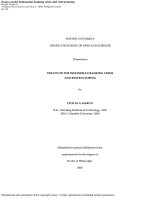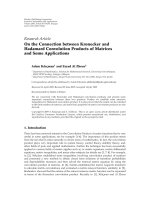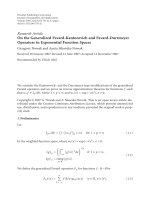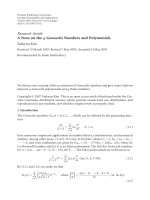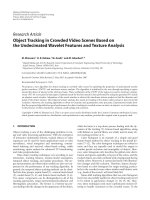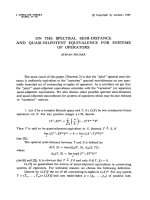Identifying factors of psychological distress on the experience of pain and symptom management among cancer patients
Bạn đang xem bản rút gọn của tài liệu. Xem và tải ngay bản đầy đủ của tài liệu tại đây (393.36 KB, 7 trang )
Baker et al. BMC Psychology (2016) 4:52
DOI 10.1186/s40359-016-0160-1
RESEARCH ARTICLE
Open Access
Identifying factors of psychological distress
on the experience of pain and symptom
management among cancer patients
Tamara A. Baker1*, Jessica L. Krok-Schoen2 and Susan C. McMillan3
Abstract
Background: Epidemiological evidence suggests the impact psychological distress has on symptomatic outcomes
(pain) among cancer patients. While studies have examined distress across various medical illnesses, few have
examined the relationship of psychological distress and pain among patients diagnosed with cancer. This study
aimed to examine the impact psychological distress-related symptoms has on pain frequency, presence of pain,
and pain-related distress among oncology patients.
Methods: Data were collected from a sample of White and Black adults (N = 232) receiving outpatient services
from a comprehensive cancer center. Participants were surveyed on questions assessing psychological distress
(i.e., worry, feeling sad, difficulty sleeping), and health (pain presence, pain frequency, comorbidities, physical
functioning), behavioral (pain-related distress), and demographic characteristics.
Results: Patients reporting functional limitations were more likely to report pain. Specifically, those reporting
difficulty sleeping and feeling irritable were similarly likely to report pain. Data further showed age and
feeling irritable as significant indicators of pain-related distress, with younger adults reporting more distress.
Conclusions: It must be recognized that psychological distress and experiences of pain frequency are
contingent upon a myriad of factors that are not exclusive, but rather coexisting determinants of health.
Further assessment of identified predictors such as age, race, socioeconomic status, and other physical and
behavioral indicators are necessary, thus allowing for an expansive understanding of the daily challenges
and concerns of individuals diagnosed with cancer, while providing the resources for clinicians, researchers,
and policy makers to better meet the needs of this patient population.
Keywords: Pain frequency, Pain presence, Psychological distress, Physical functioning
Background
Despite advances in supportive cancer care, psychological
distress remains as a significant issue among individuals
diagnosed with cancer [1, 2]. The level of psychological
and emotional distress associated with a cancer diagnosis
contributes to increased rates of co-morbidities and mortality, while reducing quality of life and adherence to medical treatment [3, 4]. The magnitude of distress is often
concomitant with the diagnosis, treatment and symptoms
associated with the chronic illness [4].
* Correspondence:
1
Department of Psychology, University of Kansas, 426 Fraser Hall, 1415
Jayhawk Blvd, Lawrence, KS 66045, USA
Full list of author information is available at the end of the article
Psychological distress and a cancer diagnosis
The diagnosis of cancer and the uncertainty of treatment
(and a cure) may evoke emotional discontent and related
psychological distress. The innumerable demands placed
on the patient puts them at a more vulnerable mental and
physical state, thus experiencing more psychological distress and distress-related symptoms. [5] While psychological distress may be all encompassing of the multiple
demands, experiences, and feelings of those diagnosed with
cancer, it remains as a source of inquiry in understanding
the influence it has among certain identified characteristics
[5, 6]. Studies show that distress dominates across a continuum of cancer types (breast, lymphoma) [6–11] and
related symptoms (sleep, fatigue, pain) [12, 13].
© The Author(s). 2016 Open Access This article is distributed under the terms of the Creative Commons Attribution 4.0
International License ( which permits unrestricted use, distribution, and
reproduction in any medium, provided you give appropriate credit to the original author(s) and the source, provide a link to
the Creative Commons license, and indicate if changes were made. The Creative Commons Public Domain Dedication waiver
( applies to the data made available in this article, unless otherwise stated.
Baker et al. BMC Psychology (2016) 4:52
Page 2 of 7
Pain and psychological distress
Method
Evidence contends a complex interaction of pain and
psychological distress among patients diagnosed with
cancer in general [10, 13]. Yet, with more advanced
stages of cancer, this dynamic relationship has shown to
impact cognition, personality, and behavior; and evoke
emotional disturbances such as depression and anxiety
[10, 12, 13]. Yet, the multi-dimensionality of the pain
and psychological distress dyad addresses something
more complicated than the diagnoses and related symptoms. Because of the nature of pain and distress-related
symptoms (e.g., depression, anxiety, worry), there is
contradictory evidence suggesting whether the pain
experience precedes or is the result of a psychological
condition/symptoms. [10, 14] This is all the more important when assessing the dynamics of pain and psychological distress among patients diagnosed with
cancer. With the emotional toll of a cancer diagnosis, it
is critical that health care professionals consider the
complexity of issues associated with the disease and how
this relationship is contingent on a myriad of cultural,
behavioral, physical, and social factors that are not
exclusive, but rather coexisting determinants of health
[14–20].
Despite documenting the relationship between psychological distress and symptoms commonly associated with disease progression; identifying the
influence of psychological distress and related symptoms on the pain experience has not been thoroughly
examined among adults diagnosed with cancer.
Guided by the concepts of the biopsychosocial (BPS)
theoretical approach, which provides a general model
conjecturing the multidimensionality of health, with
the amalgamation of biological, psychological and
social factors contributing to the context of health
and illness [21, 22], this study examined the influence
and association of identified psychological distressrelated symptoms (worry, feeling sad, difficulty sleeping, difficulty concentrating, feeling nervous, feeling
irritable), and health (comorbidities, physical functioning) and demographic characteristics as determinant
indicators of pain frequency, presence of pain, and
pain-related distress. To contribute to our understanding of these relationships, this study specifically
aimed to: (1) describe the frequency of identified
psychological-distress related indicators, (2) examine
factors associated with pain-related distress, pain frequency, and pain presence, (3) determine the amount
of unique variance in pain frequency and pain-related
distress accounted for by specific health variables,
while controlling for demographic and psychologicaldistress related symptoms (independently and collectively), and (4) predict the pattern of pain presence in
a sample of patients diagnosed with cancer.
Participants
Data were taken from a parent project designed to
examine pain, adherence to pain medication, and constipation among patients receiving outpatient services from
a National Cancer Institute (NCI)-Designated Comprehensive Cancer Center. To be included for study participation patients had to self-identify as non-Hispanic
White or Black; ≥ 18 years of age; have a cancer diagnosis at any stage; currently receiving cancer treatment
(i.e., radiation, chemotherapy, or combination); be cognitively intact; and able to provide written informed consent to participation. Patients who enrolled in a cancer
pain intervention or non-pharmacologic intervention
within the past year, or unable to read and understand
English, were not eligible to participate in the project.
This investigation was approved by the university’s Institutional Review Board and the cancer center’s Protocol
Review Monitoring Committee.
Procedure
Data were collected through chart reviews and patient
interviews assessing specific psychological distressrelated symptoms, pain, and health and demographic
characteristics. Research Assistants were responsible for
patient recruitment, interviews, and administering the
questionnaire. All patients were approached by a
Research Assistant during the patient’s medical visit
(either in the waiting area, while being triaged, or receiving treatment) to determine their interest and eligibility
for study participation. Upon providing consent, each
interview (and survey) lasted approximately 30 min and
was conducted in a private area in the clinic.
Measures
Dependent variable
Pain (frequency, presence, and related-distress) Pain
frequency, presence, and pain related-distress were
assessed using the 32-item Memorial Symptom Assessment Scale (MSAS). The measure consists of two validated subscales: physical symptoms (PHYS) and
psychological (PSYCH), that assess the frequency, presence, and distress related to each symptom. For purposes of this investigation, only the pain symptom from
the PHYS subscale (frequency, presence, and distress
scores) was included in subsequent analyses. The presence of pain was assessed as a dichotomous variable,
with response choices as either yes or no (experiencing
pain or not). Pain frequency was measured on a fivepoint Likert scale (0 = not at all to 4 = very severe), with
a higher score endorsing more of the symptom. Painrelated distress was similarly rated on a five-point Likert
scale (how much does the symptom distress or bother
Baker et al. BMC Psychology (2016) 4:52
you; 0 = not at all to 4 = very much), with higher
scores suggesting more distress resulting from pain.
The MSAS has established validity and reliability
among patients diagnosed with cancer and undergoing cancer treatment [23].
Independent variables
Psychological symptoms
The MSAS-PSYCH subscale was used to measure the
frequency, presence, and distress associated with six
psychological symptoms (difficulty concentrating,
feeling nervous, difficulty sleeping, feeling sad, worry,
feeling irritable). Symptom frequency was measured
on a five-point Likert scale (0 = not at all to 4 =
very severe), with a higher score endorsing more of
the symptom. Presence of the symptom was assessed
as a dichotomous variable, with response choices as
either yes or no (experiencing the symptom or not).
Symptom-related distress was similarly rated on a
five-point Likert scale (how much does the symptom
distress or bother you; 0 = not at all to 4 = very
much), with higher scores denoting more distress related to the symptom. Previous studies report strong
reliability coefficients for the psychological subscale
(α = 0.83-0.88) [23]. Scale analysis for this study revealed similar internal consistency for the PSYCH
subscale (α = 0.73).
Health variables
A series of single-item questions assessed the patient’s primary metastatic site, stage of disease, treatment stage (under treatment with curative, under
treatment with palliative, or in remission), and cause
of pain (cancer-related, non-cancer related or both).
Level of performance (i.e., physical functioning) was
measured using the Eastern Cooperative Oncology
Group Performance Status (ECOG-PS). Response
choices were rated on a five-point Likert scale, with
higher scores suggesting complete disability (0 = fully
active to 4 = completely disabled) [24, 25].
Demographics characteristics
Five demographic variables were included in the analyses: age, sex, race/ethnicity, education, and marital status. Age was scored in a continuous format. Sex was
treated as a dichotomous variable (male/female). Race
was assessed via five nominal categories (White/Caucasian, Black/African American, Hispanic/Non-Caucasian,
Asian/Pacific Islander, and other). Education was
assessed as the total number of years of formal schooling. Marital status was scored as a dichotomous variable
(divorced/widowed/single vs. married).
Page 3 of 7
Statistical analysis
Descriptive analyses were calculated to check for missing
and outlying data, and to provide a profile of the sample’s demographic (age, race, gender, education, marital
status), health (metastatic site, stage of disease, treatment stage, cause of pain, physical functioning), and
pain (frequency, presence, related-distress) characteristics, and psychological symptoms (difficulty concentrating, feeling nervous, difficulty sleeping, feeling sad,
worrying, feeling irritable). A series of Pearson ProductMoment correlation coefficients (pairwise deletion) were
examined to assess the strength of the bivariate associations between pain frequency and each psychological
symptom (PSYCH variables). A forward stepwise logistic
regression model was calculated to determine significant
predictors of pain presence (yes/no), with sex, race, education, age, marital status, physical functioning, and the
six PSYCH variables entered as covariates in the final
regression model. Separate hierarchical multiple regression models were similarly calculated to determine the
amount of unique variance in pain frequency and related
distress accounted for by specific health variables, while
controlling for the demographic and psychological
symptoms (independently and collectively).
The regression procedure entered the predictor variables in three models. Demographic variables (age,
race, sex, education, marital status) were entered first
(Model I), followed by physical functioning (ECOG)
(Model II). The psychological symptoms (PSYCH variables) were entered as the final set of predictor variables (Model III). Standardized beta coefficients were
reported to describe the relative importance of the
predictor variables within the regression model. Statistical significance for all analyses were determined
with the probability of a Type I error, p ≤ .05. All
statistical analyses were performed with the Statistical
Package for Social Sciences (SPSS Inc., Chicago, IL)
version 22.0.
Results
Demographic, pain, and health characteristics
Data consisted of 232 adult patients, with a mean age
of 55 (SD = 12.24) years and 13.64 (SD = 2.43) years
of education. The majority of the sample were white
(85 %), with an equal number of males (n = 116) and
females (n = 116). Sixty-seven percent of the participants were married, with more than half residing with
a spouse (60 %) and living in their own home (93 %).
Lymphoma (23 %), lung (15 %), and breast (15 %)
were the most common cancer diagnoses. Less than
half of the sample (47 %) was diagnosed at a stage
IV, with 21 % not knowing their diagnostic stage.
Approximately 58 % of the patients reported their
pain as cancer-related, with less than one-third
Baker et al. BMC Psychology (2016) 4:52
Page 4 of 7
reporting pain as a result of both cancer and a noncancer medical condition(s). The sample reported an
average of 2.48 ± 1.08 (0–4 Likert scale) on pain frequency, with a similar score of 2.60 ± 1.22 for related
distress. Other demographic and health characteristics
are provided in Table 1.
Table 2 Prevalence of distress-related symptoms
PSYCH variables
Percent
Difficulty Concentrating
41
Feeling Nervous
31
Difficulty Sleeping
55
Feeling Sad
41
Presence, frequency, and distress of psychological
symptoms
Symptom presence
Worrying
52
Feeling Irritable
45
Table 2 shows that more than half of the participants
reported difficulty sleeping and being worried, with
another 45 % feeling irritable. Forty-one percent of the
patients reported feeling sad and difficulty concentrating, with approximately one-third of the sample feeling
nervous. Participants had an overall PSYCH symptom
distress and frequency mean score of 1.71 SD = 1.23)
and 1.61 (SD = 1.07), respectively.
between patients who reported being distressed from
their pain (bothered by their pain) and being irritated
(r = .22, p < .01). None of the remaining psychological symptoms were associated with pain-related
distress (Table 3).
Symptom frequency and distress
Difficulty sleeping (M = 2.32, SD = 1.08) and worry
(M = 2.15, SD = 1.10) were reported as the most
frequent psychological symptom, with difficulty concentrating (M = 1.74, SD = .92) and feeling sad (M =
1.85, SD = 1.02) as the least frequent. Similarly, difficulty sleeping (M = 2.50, SD = 1.22) and feeling
nervous (M = 2.34, SD = 1.29) were the most psychologically distressing symptom, with difficulty concentrating (M = 1.99, SD = 1.41) and feeling irritable (M = 2.07,
SD = 1.26) as the least distressing.
Association of psychological symptoms and pain
presence, frequency, and distress
The presence of pain was significantly associated with all
six PSYCH variables: feeling nervous (r = .26, p < .001),
feeling sad (r = .28, p < .001), worry (r = .32, p < .001),
being irritated (r = .34, p < .001), difficulty sleeping (r =
.19, p < .01), and concentrating (r = .30, p < .001). None
of the six PSYCH variables were related to pain frequency. Results further showed a moderate relationship
Table 1 Demographic, health, and pain characteristics (N = 232)
Variables
M ± SD/%
Age
55.6 ± 12.2
Female (n)
116
Education
13.64 ± 2.43
Marital Status (% married)
67 %
Pain due to cancer
58 %
Physical functioning (ECOG; able to do light housework)
59 %
Pain presence (yes/no)
75 %
Pain-related distress
2.60 ± 1.22
Pain frequency
2.48 ± 1.08
Pattern of pain presence
Predictors of the presence of pain (yes/no) were calculated
after controlling for demographic, health, and psychological
covariates (i.e., age, race, sex, marital status, education,
physical functioning), and the six psychological symptoms
(difficulty concentrating, feeling nervous, difficulty sleeping,
feeling sad, worrying, feeling irritable). Table 4 shows that
younger patients (OR = .96, 95 % CI = .93 - .99 p < .05)
were more likely to report pain than the older patients. It
was similarly found that patients with more (physical) functional limitations (OR = 3.82, 95 % CI = 1.90 - 7.65; p <
.001) were three times more likely to report pain. Analyses
further showed that patients who reported difficulty sleeping (OR = 2.25, 95 % CI = 1.02 - 4.95; p < .05) and feeling
irritable (OR = 2.95, 95 % CI = 1.14 - 7.62; p < .05) were
similarly likely to report pain. None of the remaining demographic, pain or psychological symptoms were statistically
significant indicators of pain presence.
Indicators of pain frequency and pain-related distress
Neither model examining the unique variance in pain
frequency (F[12, 168] = 1.43, p = NS) and pain-related
Table 3 Association between pain (Presence and distressrelated) and psychological variables
PSYCH variables
r
Pain presence
Difficulty Concentrating
.30**
Feeling Nervous
.26**
Difficulty Sleeping
.19*
Feeling Sad
.28**
Worrying
.32**
Feeling Irritable
.34**
Pain-related Distress
Feeling Irritable
*
p < .01; **p < .001
.22*
Baker et al. BMC Psychology (2016) 4:52
Page 5 of 7
Table 4 Indicators of pain presence
complexity of a cancer diagnosis and how these
symptoms (e.g., pain, depression, physical impairment)
co-exist with one another [23].
While the Institute of Medicine (IOM) acknowledges
pain as a disease in itself, it is similarly recognized as a
serious outcome for a number of physically debilitating
medical conditions. Dekker and colleagues [26] provide
a cogent description of the path from disease to physical
impairment, citing that avoidance of certain pain-related
activities promote a self-reinforcing cycle of activity
avoidance, pain and limited functional capacity. Several
investigations show similar findings among cancer patients [27–30]. Despite the known benefits of physical
activity, we must recognize some of the barriers a cancer
diagnosis presents on a patient’s ability to perform
certain physical everyday tasks. For example, asking a
patient to walk one half of a mile each day (as a means
of exercise) may be a serious challenge, particularly for
those who may recently received treatment (e.g., radiation, surgery). Not only are there the physical demands
of performing the task, but there are the emotional (e.g.,
depression) constraints that may impact one’s ability or
willingness to perform the activity.
We similarly found that age was an important indicator of pain, with younger patients reporting more pain
than their older counterparts. Our findings corroborate
with prior research suggesting that the experience of
pain and related psychological distress differs across age
groups, with older cancer patients reporting less pain
frequency, frequency of distress than younger patients
[31–33]. This may be the result of the elderly patient
having developed more effective coping mechanisms to
deal with the burden and experience of pain [32]. There
is also the notion that the elderly patient may have accepted the pain as part of the aging process. This, of
course, is and should not be normative thinking, considering the number of elder adults who neither report nor
experience pain; acute, chronic, or otherwise. Examining
the pain experience among older cancer patients continues to be a growing public health concern that warrants further investigation.
As with age, we found that more than half of the patients reported difficulty with sleep as the most frequent
and distressing psychological symptom. Results further
showed that those who reported pain were more likely
to experience difficulty sleeping. Among the general
population, more than half of individuals reporting
chronic pain also report problems with sleep [34]. Failure to treat pain adequately may lead to decreased functional status, mood, and sleep disturbances [35]. Other
social factors, such as race, have also been shown to
impact sleep habits and patterns among patients experiencing chronic pain. Green and colleagues [36] found
that blacks, men, and younger adults reporting chronic
Variables
Odds ratio
p-value
95 % CI
Age
.96
<.05
.93–.99
Physical functioning
3.82
<.001
1.90–7.65
Difficulty sleeping
2.25
<.05
1.02–4.95
Feeling irritable
2.95
<.05
1.14–7.62
Variables initially tested: age, race, sex, education, marital status, physical
functioning, pain presence, worry, difficulty sleeping, feeling sad, irritable,
difficulty concentrating, feeling nervous
distress (F[12, 166] = 1.73, p = NS) was significant.
Although the collective models were not significant,
there were individual variables that contributed to the
variance of each dependent variable (pain frequency and
related distress).
For pain frequency as the outcome variable, the first
step in model development involved entering the demographic variables (race, age, sex, education, and marital
status; Model I), which accounted for 7 % of the total
variance. Age (β = -.17, p < .05) was the only significant
demographic predictor in the first model, with younger
adults experiencing more pain. Physical functioning was
entered in the second model (Model II), and was not a
significant indicator of pain frequency. Age, however
was retained as a significant predictor (β = -.19, p < .05)
when entered in Model II. After controlling for the
demographic and health indicators, none of the psychological symptoms (Model III) were significant indicators.
The effect of age was the only variable that remained as
a significant predictor of pain frequency, after controlling for all other variables.
Similarly, the pain-related distress model was not
significant, however the final model showed that age
(β = -.17, p < .05) and feeling irritable (β = .23, p < .01)
were significant indicators of pain related-distress.
Discussion
There is a continued need to understand the impact psychological distress and related symptoms have on the
pain experience among those diagnosed with cancer.
This study aimed to quantify the effects of identified
distress-related symptoms on pain frequency, presence,
and distress among Black and White patients receiving
outpatient services at a comprehensive cancer center.
Results showed interesting preliminary data on the
effects of identified psychological symptoms on painrelated health outcomes.
With more than 75 % of the sample reporting pain,
these results are significant in documenting the pain
and psychological well-being dyad among cancer
patients. The continued need to understand the
multi-faceted approach to achieving optimal pain
management, in addition to assessing the patient’s
pain frequency and related distress, validates the
Baker et al. BMC Psychology (2016) 4:52
pain had a higher prevalence of poor sleep quality. Further studies examining these and other social factors
may provide a more comprehensive assessment of the
impact pain has on sleep patterns among cancer patients
in general and among those from diverse race groups in
particular. Knowledge of the nature and prevalence of
sleep problems can provide the basis for new approaches
to supportive care, as many sleep problems can be
effectively treated [37].
The study results stress the importance of psychosocial
care and services for cancer patients and their families.
One strategy, cognitive-behavioral therapy (CBT), has
been effective in improving pain and pain-related problems among cancer patients [38, 39]. Furthermore,
tailored CBT approaches to address identified predictors
such as age, race, SES, and behaviors, can result in
greater improvements of the cancer patient’s pain experience [39, 40]. More research is needed as CBT trials
among cancer survivors are limited. Thus, CBT and
other evidence-based strategies need to be better understood and practiced within a multidisciplinary team involving oncologists, nurses, social workers, physical and
occupational therapists, psychologists, psychiatrists, etc.
in order address the biopsychosocial needs of the cancer
patient and their families.
Although this study demonstrated pain and specific
psychological distress-related symptoms, there were
some limitations that must be acknowledged. First, the
cross-sectional design of the study does not allow for an
analysis of reported relationships over time, particularly
as we focus on indicators of pain, sleep and psychological distress. Future studies can benefit in using a longitudinal design to examine the temporal relationship of
these study variables. Second, because the study participants were primarily White, with at least a high school
education, the study results cannot be generalized to
other race (or socioeconomic status) populations.
Additionally, the criteria for study participation was not
limited to a specific cancer diagnosis, prognosis, or treatment regimen, therefore we cannot definitively compare
these findings to other studies examining specific cancer
diagnoses. Similarly, while all the patients were diagnosed with cancer, the pain associated with the disease
was not discernible between that of cancer and/or of
another chronic medical illness (although more than half
reported their pain was due to cancer).
Conclusions
Results from this study add to the limited research
exploring how specific distress-related symptoms influence reports of pain (frequency, presence, distress-related)
in adult cancer patients. Future research on psychological
distress and other social indicators, such as satisfaction
with pain management/treatment, race, sex, and
Page 6 of 7
socioeconomic status are needed. Specifically, assessing
the influence of satisfaction with pain treatment may yield
needed information for health care professionals to better
understand the level of distress, which may impact treatment adherence and/or seeking medical care. Establishing
this knowledge-base can inform education for health care
providers, while providing a quality of improvement for
systems that provide care to patients with cancer.
Further assessment of identified predictors such as age,
race or ethnicity, socioeconomic status, and other physical, behavioral and social indicators may similarly allow
for a comprehensive understanding of the daily challenges
and concerns of the cancer patient, while providing the resources for nurses, clinicians, and researchers to better
meet the needs of this patient population.
Abbreviations
BPS: Biopsychosocial; ECOG-PS: Eastern cooperative oncology group
performance status; IOM: Institute of medicine; MSAS: Memorial symptom
assessment scale; NCI: National cancer institute; PHYS: Physical symptoms;
PSYCH: Psychological
Acknowledgements
The authors are very grateful to all the participants who completed the
survey in the parent study and the clinical staff who supported this research
and assisted with participant recruitment.
This research received no specific grant from any funding agency in the
public, commercial, or not-for-profit sectors.
Availability of data and materials
This submission is presented as a secondary data analysis. The third author
of this manuscript was the PI of this investigation. As a result, data can be
made available upon request.
Authors’ contributions
TAB: made substantial contributions to conception and design, acquisition
of data, analysis and interpretation of data, and was involved in drafting the
manuscript. JLK: acquisition of data, analysis and interpretation of data, and
was involved in drafting the manuscript. SCM: is the PI and provided data,
revised for important intellectual content and gave final approval of the
version to be published. All authors read and approved the final manuscript.
Competing interests
The authors declare that they have no competing interests.
Consent for Publication
Not applicable.
Ethics approval and consent to participate
This investigation was approved by the University of South Florida’s
Institutional Review Board and Moffitt Cancer Center’s Protocol Review
Monitoring Committee.
The following statement outlines the study’s inclusion criteria, by which
participants had to provide written informed consent.
To be included for study participation patients had to self-identify as
non-Hispanic White or Black; ≥ 18 years of age; have a cancer diagnosis at
any stage; currently receiving cancer treatment (i.e., radiation, chemotherapy,
or combination); be cognitively intact; and able to provide written informed
consent to participation.
Author details
1
Department of Psychology, University of Kansas, 426 Fraser Hall, 1415
Jayhawk Blvd, Lawrence, KS 66045, USA. 2Comprehensive Cancer Center, The
Ohio State University, 1590 N High St., Suite 525, Columbus, OH 43210, USA.
3
University of South Florida, College of Nursing, 12901 Bruce B. Downs Blvd,
MDC Box 22, Tampa, FL 33612, USA.
Baker et al. BMC Psychology (2016) 4:52
Received: 18 May 2016 Accepted: 19 October 2016
References
1. Patrick D, Ferketich SL, Fram PS, et al. National Institutes of Health state of
the science conference statement: symptom management in cancer: pain,
depression and fatigue. July 15–17, 2002. J Natl Cancer Inst Monogr.
2004;95(15):1110–7.
2. Harrison JD, Young JM, Price MA, Butow PN, Solomon MJ. What are the
unmet supportive care needs of people with cancer? A systematic review.
Support Care Cancer. 2009;17(8):1117–28.
3. Linden W, Vodermaier A, MacKenzie R, Greif D. Anxiety and depression after
cancer diagnosis: Prevalence rates by cancer type, gender, and age. J Affect
Disord. 2012;141:343–51.
4. Lowery AE, Greenberg MA, Foster SL, Clark K, Casden DR, Loscalzo M,
Bardwell WA. Validation of a needs-based biospychosocial distress
instrument for cancer patients. Psychooncology. 2012;21:1099–106.
5. Kirkova J, Walsh D, Rybicki L, et al. Symptom frequency and distress in
advanced cancer. Palliat Med. 2010;24(3):330–9.
6. Ryan D, Gallagher P, Wright S, Cassidy E. Methodological challenges in
researching psychological distress and psychiatric morbidity among patients
with advanced cancer: What does the literature (not) tell us? Palliat Med.
2011;26(2):162–77.
7. Kasparian NA, Sansom-Daly U, McDonald RP, Meiser B, Butow PN, Mann GJ.
The nature and structure of psychological distress in people at high risk for
melanoma: a factor analytic study. Psycho-Oncology. 2012;21:845–56.
8. Mertz BG, Bistrup PE, Johansen C, Dalton SO, Deltour I, Kehlet H, Kroman N.
Psychological distress among women with newly diagnosed breast cancer.
Eur J Oncol Nurs. 2012;16:439–43.
9. Poe JK, Hayslip JW, Studts JL. Decision making and distress among
individuals diagnosed with follicular lymphoma. J Psychosoc Oncol.
2012;30:426–45.
10. Krok J, Baker TA, McMillan SC. Age differences in the presence of pain and
psychological distress in younger and older cancer patients. J Hosp Palliat
Nurs. 2013;15(2):107–13.
11. Shen Johnson M, Redd WH, Winkel G, Badr H. Associations among pain,
pain attitudes, and pain behaviors in patients with metastatic breast cancer.
J Behav Med. 2014;37(4):595–606.
12. Nishiura M, Tamura A, Nagai H, Matsushima E. Assessment of sleep
disturbance in lung cancer patients: relationship between sleep
disturbance and pain, fatigue, quality of life and psychological distress.
Palliat Support Care. 2015;13(3):575–81.
13. Zara C, Baine N. Cancer pain and psychosocial factors: A critical review of
the literature. J Pain Symptom Manage. 2002;24(5):526–42.
14. Mystakidou K, Tsilika E, Parpa E, Katsouda E, Galanos A, Vlahos L. Psychological
distress of patients with advanced cancer. Cancer Nurs. 2006;29(5):400–5.
15. Arraras JL, Wright SJ, Jusue G, Tejedor M, Calvo JI. Coping style, locus of
control, psychological distress and pain-related behaviours in cancer and
other diseases. Psychol Health Med. 2002;7(2):181–7.
16. Linden W, Girgis A. Psychological treatment outcomes for cancer patients:
what do meta-analyses tell us about distress reduction? Psychooncology.
2012;21:343–50.
17. Baker TA, Green CR. Intrarace differences among Black and White Americans
presenting for chronic pain management: The influence of age, physical
health, and psychosocial factors. Pain Med. 2005;6(1):29–38.
18. Krok JL, Baker TA, McMillan, S. Age differences in the presence of pain and
psychological distress in younger and older cancer patients. J Hosp Palliat
Nurs. 2013;16(2):107–113.
19. Ashing-Giwa KT, Padilla G, Tejero J, et al. Understanding the breast cancer
experience of women: A qualitative study of African American, Asian
American, Latina and Caucasian cancer survivors. Psychooncology.
2004;13(6):408–28.
20. Krok-Schoen J, Baker TA. Gender differences in personality and cancerrelated pain among older cancer patients. Journal of Gender Studies. 2015.
(E-published ahead of print).
21. Hadijstavropoulos T, Craig KD, Duck S, Cano A, Goubert L, Jackson PL.
Fitzgerald TD.A biopsychosocial formulation of pain communication.
Psychol Bull.
22. Portenoy RK, Thaler HT, Kornblith AB, et al. The Memorial Symptom
Assessment Scale: an instrument for the evaluation of symptom prevalence,
characteristics and distress. Eur J Cancer. 1994;30A(9):1326–36.
Page 7 of 7
23. McMillan SC, Tofthagen C, Morgan MA. Relationships among pain, sleep
disturbances, and depressive symptoms in outpatients from a
comprehensive cancer center. Oncol Nurs Forum. 2008;35(4):603–11.
24. McMillan SC, Small BJ, Haley WE. Improving hospice outcomes through
systematic assessment: A clinical trial. Cancer Nurs. 2011;34(2):89–97.
25. Dekker J, Boot B, van der Woude LHV, Bijlsma JWJ. Pain and Disability in
Osteoarthritis: A Review of Biobehavioral Mechanisms. J Behav Med.
1992;15:189–213.
26. Oken MM, Creech RH, Tormey DC, Horton J, David TE, McFadden ET, et al.
Toxicity and response criteria of the Eastern Cooperative Oncology Group.
Am J Clin Oncol. 1982;5(6):649–55.
27. Lynch BM, Cerin E, Owen N, Aitken JF. Associations of leisure-time physical
activity with quality of life in a large, population-based sample of colorectal
cancer survivors. Cancer Causes Control. 2007;18(7):735–42.
28. Trinh L, Plotnikoff RC, Rhodes RE, North S, Courneya KS. Associations of
leisure-time physical activity with quality of life in a large, population-based
sample of colorectal cancer survivors. Cancer Epi Biomarkers Prevent.
2011;21(2):859–68.
29. Wiggins MS, Simonavice EM. Cancer prevention, aerobic capacity, and
physical functioning in survivors related to physical activity: A recent review.
Cancer Manag Res. 2010;2:157–64.
30. Gagliese L, Jovellanos M, Zimmermann C, Shobbrook C, Warr D, Rodin G.
Age-related patterns of adaption to cancer pain: A mixed method study.
Pain Med. 2009;10(6):1050–61.
31. Lo C, Lin J, Gagliese L, Zimmermann C, Mikulincer M, Rodin G. Age and
depression in patients with metastatic cancer: The protective effects of
attachment security and spiritual wellbeing. Ageing Soc. 2010;30(2):325–36.
32. Politi MC, Enright TM, Weihs KL. The effects of age and emotional
acceptance on distress among breast cancer patients. Support Care Cancer.
2007;15:73–9.
33. Davison SN, Jhangri GS. The impact of chronic pain on depression, sleep,
and the desire to withdraw from dialysis in hemodialysis patients. J Pain
Symptom Manage. 2005;30(5):465–73.
34. Pilowsky L, Crettenden I, Townley M. Sleep disturbance in pain clinic
patients. Pain. 1985;23:27–33.
35. Green CR, Nadao-Brumblay SK, Hart-Johnson T. Sleep problems in a racially
diverse chronic pain population. Clin J Pain. 2009;25(5):423–30.
36. Morris BA, Thorndike FP, Ritterband LM, Glozier N, Dunn J, Chambers SK.
Sleep disturbance in cancer patients and caregivers who contact
telephone-based help services. Support Care Cancer. 2015;23(4):1113–20.
37. Baker TA, Whitfield KE. Intrarace group variability in characteristics of selfreported pain and sleep difficulty in older African Americans with arthritis.
J Transcult Nurs. 2015;26:171–77.
38. Tatrow K, Montegomery GH. Cognitive behavioral therapy techniques for
distress and pain in breast cancer patients: a meta-analysis. J Behav Med.
2006;29(1):17–27.
39. Syrjala KL, Jensen MP, Mendoza ME, Jean CY, Fisher HM, Keefe FJ.
Psychological and behavioral approaches to cancer pain management.
J Clin Oncol. 2014;32(16):1703–11.
40. Dalton JA, Keefe FJ, Carlson J, Youngblood R. Tailoring cognitive-behavioral
treatment for cancer pain. Pain Manage Nurs. 2004;5(1):3–18.
Submit your next manuscript to BioMed Central
and we will help you at every step:
• We accept pre-submission inquiries
• Our selector tool helps you to find the most relevant journal
• We provide round the clock customer support
• Convenient online submission
• Thorough peer review
• Inclusion in PubMed and all major indexing services
• Maximum visibility for your research
Submit your manuscript at
www.biomedcentral.com/submit


